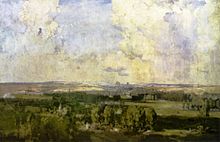
Charles Edwin Woodrow Bean, usually identified as C. E. W. Bean, was an historian and one of Australia's official war correspondents. According to the Online International Encyclopedia of the First World War, no other Australian has been more influential in shaping the way the First World War is remembered in Australia. He was a primary advocate in establishing the Australian War Memorial (AWM).
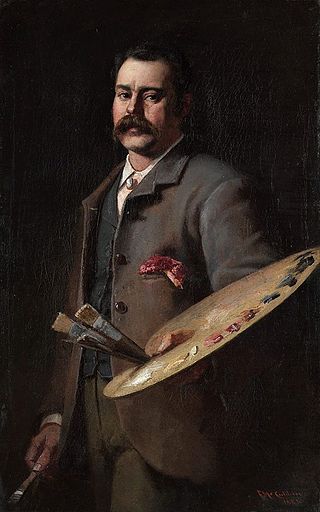
Frederick McCubbin was an Australian artist, art teacher and prominent member of the Heidelberg School art movement, also known as Australian impressionism.

A war artist is an artist either commissioned by a government or publication, or self-motivated, to document first-hand experience of war in any form of illustrative or depictive record. War artists explore the visual and sensory dimensions of war, often absent in written histories or other accounts of warfare.

Sir John Campbell Longstaff was an Australian painter, war artist and a five-time winner of the Archibald Prize for portraiture. His cousin Will Longstaff was also a painter and war artist.

George Washington Thomas Lambert was an Australian artist, known principally for portrait painting and as a war artist during the First World War.

Frederick William Leist was an Australian artist. During the First World War, he was an official war artist with Australian forces in Europe.
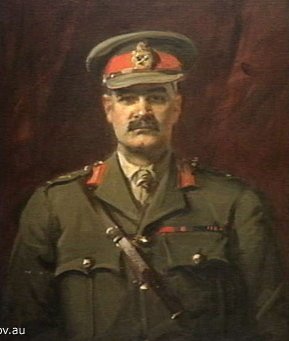
Major General Harold William Grimwade, was an Australian businessman and pharmacist, and a senior officer in the Australian Army.

William Frederick Longstaff was an Australian painter and war artist best known for his works commemorating those who died in the First World War.
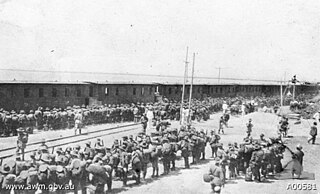
The 17th Battalion was an infantry battalion of the Australian Army. Although its numerical designation was bestowed upon it during World War I, the 17th Battalion can trace its lineage back to 1860, when a unit of the New South Wales Volunteer Rifles was raised in St Leonards, New South Wales. This unit has since been disbanded and reformed a number times. Through its links with the units of the colonial New South Wales defence force, the battalion's history includes service in the Sudan and South Africa. During World War I, the 17th Battalion was raised for overseas service as part of the Australian Imperial Force. Attached to the 5th Brigade, 2nd Division, the battalion was raised in 1915 and sent to Egypt initially, before taking part in the fighting at Gallipoli against the Turks. Later the battalion was sent to the Western Front in France and Belgium, where it served in the trenches as part of the Australian Corps. Throughout the course of the war, the battalion won numerous battle honours and its members received many individual awards, however, at the end of the war the battalion was disbanded in April 1919.
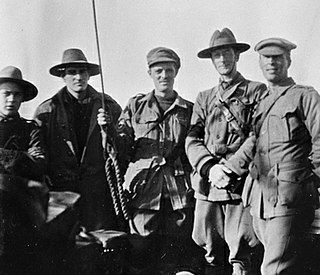
Francis Rossiter Crozier was a war records artist who is represented in the Australian War Memorial's art collection along with other Australian official war artists such as H. Septimus Power, Arthur Streeton, George Washington Lambert and Ivor Hele.
The National Gallery of Victoria Art School, associated with the National Gallery of Victoria, was a private fine arts college founded in 1867 and was Australia's leading art school of 50 years.
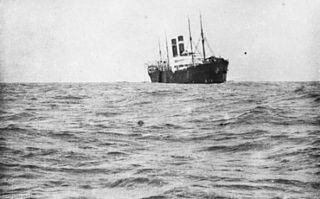
SS Vaderland was an ocean liner launched in July 1900 for the Red Star Line service between Antwerp and New York. During her passenger career, the ship initially sailed under British registry, but was re-registered in Antwerp in 1903. Vaderland was a sister ship to Zeeland and a near sister ship to Kroonland and Finland.
Andrew Christopher Fogarty was an Australian rules footballer who played with Essendon and University in the Victorian Football League (VFL).

The First World War, which was fought between 1914 and 1918, had an immediate impact on popular culture. In over the hundred years since the war ended, the war has resulted in many artistic and cultural works from all sides and nations that participated in the war. This included artworks, books, poems, films, television, music, and more recently, video games. Many of these pieces were created by soldiers who took part in the war.

John Linton Treloar, OBE was an Australian archivist and the second director of the Australian War Memorial (AWM). During World War I he served in several staff roles and later headed the First Australian Imperial Force's (AIF) record-keeping unit. From 1920 Treloar played an important role in establishing the AWM as its director. He headed an Australian Government department during the first years of World War II, and spent the remainder of the war in charge of the Australian military's history section. Treloar returned to the AWM in 1946, and continued as its director until his death.
Canadian official war artists create an artistic rendering of war through the media of visual, digital installations, film, poetry, choreography, music, etc., by showing its impact as men and women are shown waiting, preparing, fighting, suffering, celebrating. These traditionally were a select group of artists who were employed on contract, or commissioned to produce specific works during the First World War, the Second World War and select military actions in the post-war period. The four Canadian official war art programs are: the First World War Canadian War Memorials Fund (CWMF), the Second World War Canadian War Records (CWR), the Cold War Canadian Armed Forces Civilian Artists Program (CAFCAP), and the current Canadian Forces Artists Program (CFAP).
Isobel Rae was an Australian impressionist painter. After training at Melbourne's National Gallery of Victoria Art School, where she studied alongside Frederick McCubbin and Jane Sutherland, Rae travelled to France in 1887 with her family, and spent most of the rest of her life there. A longstanding member of the Étaples art colony, Rae lived in or near the village of Étaples from the 1890s until the 1930s. During that period, Rae exhibited her paintings at the Royal Society of British Artists, the Society of Oil Painters, and the Paris Salon. During World War I, she was a member of the Voluntary Aid Detachment and worked throughout the war in Étaples Army Base Camp. She and Jessie Traill were the only Australian women to live and paint in France during the war, however they were not included in their country's first group of official war artists. Following Hitler's rise to power, Rae moved to south-eastern England, where she died in 1940.
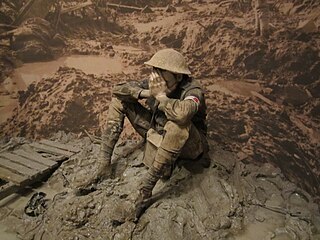
Man in the mud is a diorama by Peter Corlett which forms part of the collection of the Australian War Memorial (AWM). It depicts an Australian soldier of World War I sitting on a muddy battlefield in France. The diorama was commissioned by the AWM in 1986, and was placed on display in 1989. Man in the mud is popular with visitors to the Memorial, and remained on display after the AWM's World War I galleries were closed for major renovations in 2013.
Alexander Colquhoun was a Scottish-born Federation era Victorian painter, illustrator and critic.
The Australian Academy of Art was a conservative Australian government-authorised art organisation which operated for ten years between 1937 and 1946 and staged annual exhibitions. Its demise resulted from opposition by Modernist artists, especially those associated with the Contemporary Art Society, though the influence of the Academy continued into the 1960s.


